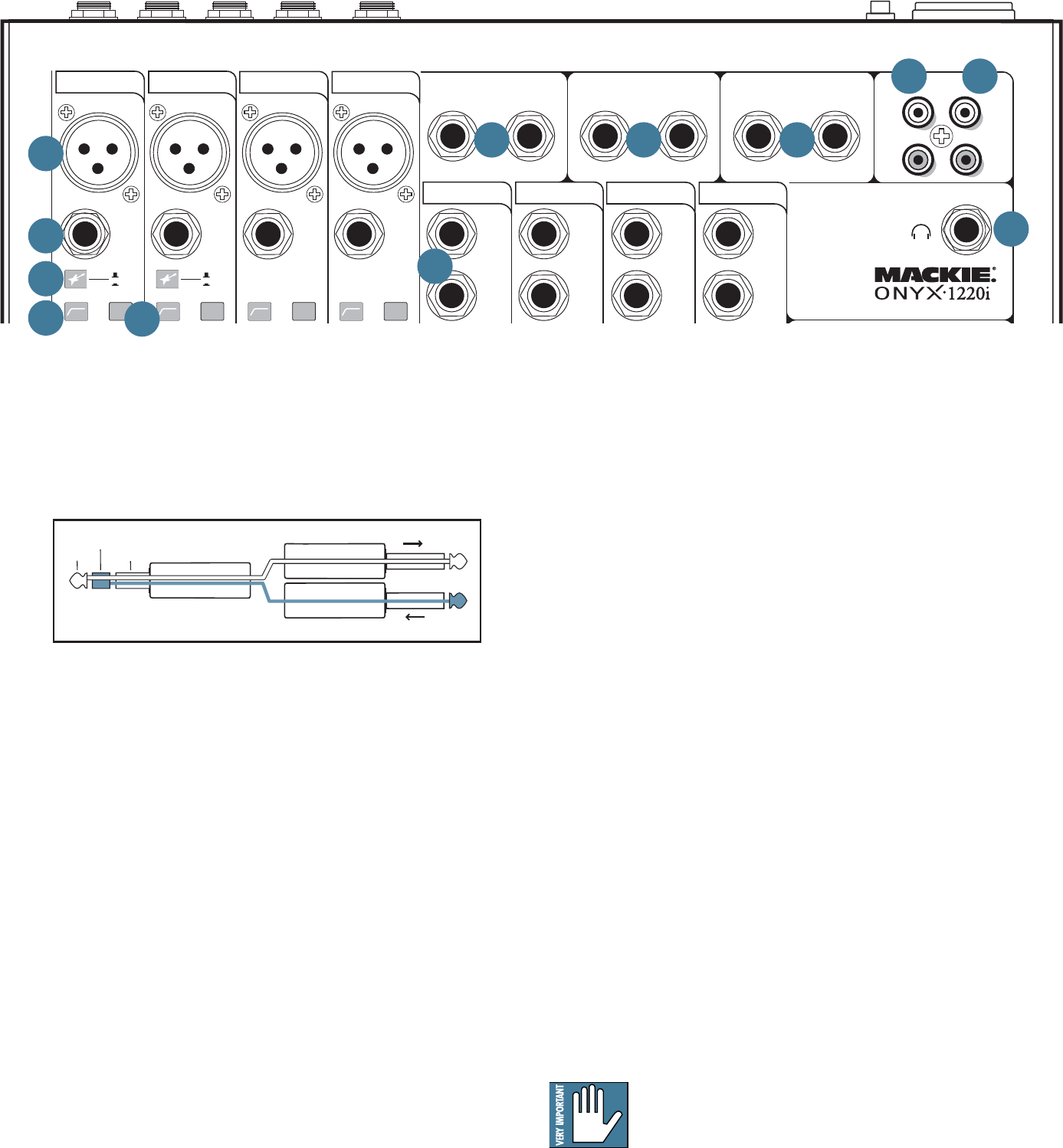
Owner's Manual 13
Professional ribbon, dynamic, and condenser mics all
sound excellent through these inputs. The mic inputs
will handle any kind of mic level you can toss at them,
without overloading.
Microphone-level signals are passed through the
mixer's splendid microphone preamplifi ers to become
line-level signals.
PHANTOM POWER
Most modern professional condenser mics require
48V phantom power, which lets the mixer send low-
current DC voltage to the mic’s electronics through the
same wires that carry audio. (Semi-pro condenser mics
often have batteries to accomplish the same thing.)
“Phantom” owes its name to an ability to be “unseen”
by dynamic mics (Shure SM57/SM58, for instance),
which don’t need external power and aren’t affected by
it anyway.
Phantom power for each channel can be selected
using that channel's phantom [20] switch.
Never plug single-ended (unbalanced)
micro phones, or ribbon mics into the mic
input jacks if phantom power is on. Do not
plug instrument outputs into the mic XLR input jacks
with phantom power on, unless you are certain it is safe.
10. MONO LINE INPUTS (Ch. 1-4)
These 1/4" jacks share circuitry (but not phantom
power) with the mic preamps, and can be driven by
balanced or unbalanced sources.
To connect balanced lines to these inputs, use a 1⁄4"
Tip-Ring-Sleeve (TRS) plug, wired as follows:
Tip = Positive (+ or hot)
Ring = Negative (– or cold)
Sleeve = Shield or ground
Insert jacks continued...
Insert jacks can be used as channel direct outputs;
post-gain, and pre-EQ. See the connector section on
page 29 (fi gure G) showing three ways to use inserts.
Connection Section
This is where you plug in things such as: microphones,
line-level instruments, guitars, effects, a recorder, PA
system, powered monitors, powered subwoofer, etc.
Check out the hookup diagrams for some connection
ideas. See Appendix B (page 28) for further details and
some rather lovely drawings of the connectors you can
use with your mixer.
9. MIC INPUTS
This is a female XLR connector, that accepts a
balanced microphone input from almost any type of
microphone. The microphone preamps feature our Onyx
design, with higher fi delity and headroom rivaling any
standalone mic preamp on the market today.
The XLR inputs are wired as follows:
Pin 1 = Shield or ground
Pin 2 = Positive (+ or hot)
Pin 3 = Negative (– or cold)
We use phantom-powered, balanced microphone
inputs just like the big studio mega-consoles, for exactly
the same reason: This kind of circuit is excellent at
rejecting hum and noise. You can plug in almost any
kind of mic that has a standard XLR-type male mic
connector.
48V 48V 48V 48V
O
N
Y
X
M
I
C
P
R
E
HI
-
Z
LINE
PREMIUM ANALOG MIXER
w/ PERKINS EQ & FIREWIRE
TAPE
MAIN OUT
IN
OUT
L
R
BAL/UNBALBAL/UNBAL
ALT 3
-
4 OUT
BAL/UNBAL
CTRL - RM OUT
LLL
L
RRR
R
(MONO)(MONO)
(MONO)
(MONO)
R/4L/3
LRLR
12
75Hz
18dB/OCT
3
75Hz
18dB/OCT
4
O
N
Y
X
M
I
C
P
R
E
HI
-
Z
LINE
O
N
Y
X
M
I
C
P
R
E
O
N
Y
X
M
I
C
P
R
E
1
LINE
2
LINE
4
LINE
3
LINE
BAL/UNBAL BAL/UNBAL BAL/UNBAL
BAL/UNBAL
BAL/UNBAL BAL/UNBAL BAL/UNBAL BAL/UNBAL
LINE IN 9-10 LINE IN 11-12LINE IN 7-8LINE IN 5-6
9
10
18
19
20
12 13 14
15 16
11
17
“tip”
This plug connects to one of the
mixer’s Channel Insert jacks.
“ring”
tip
ring
sleeve
SEND to processor
RETURN from processor
(TRS plug)


















